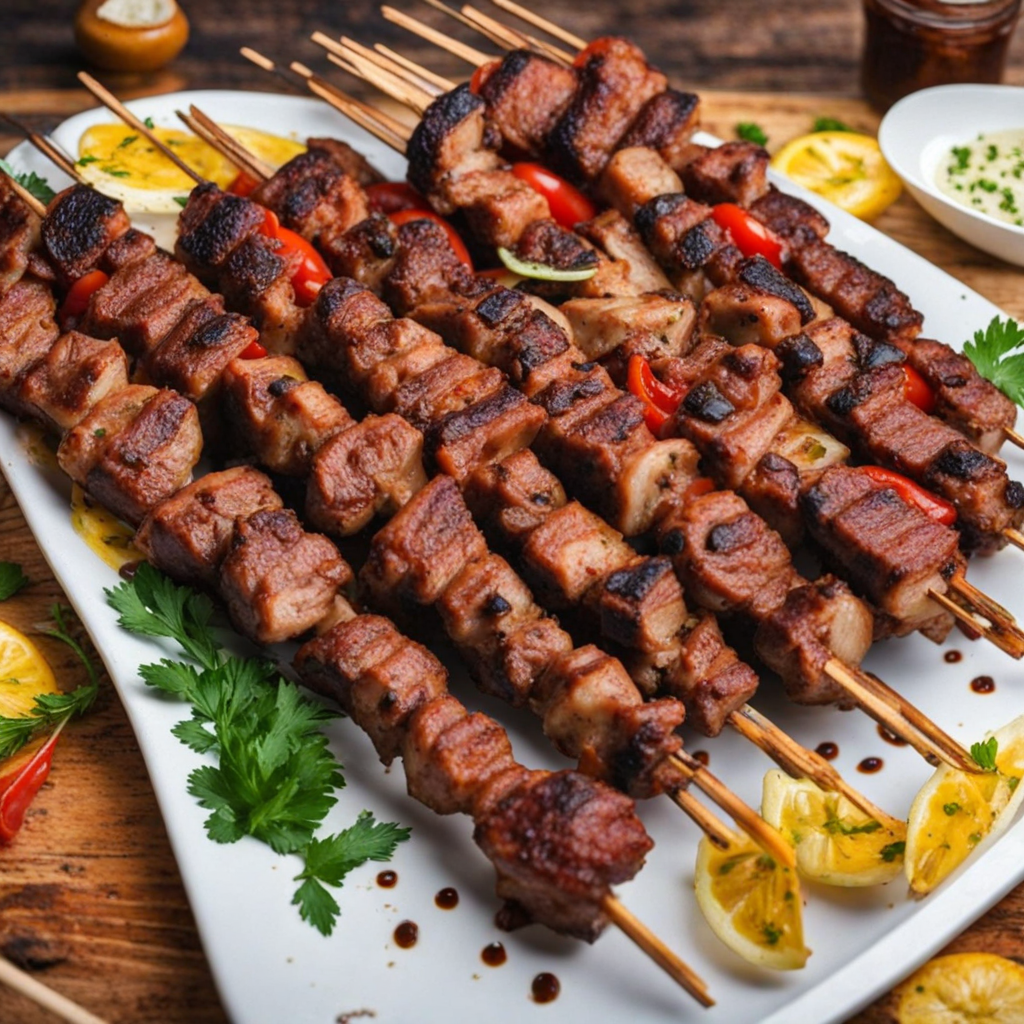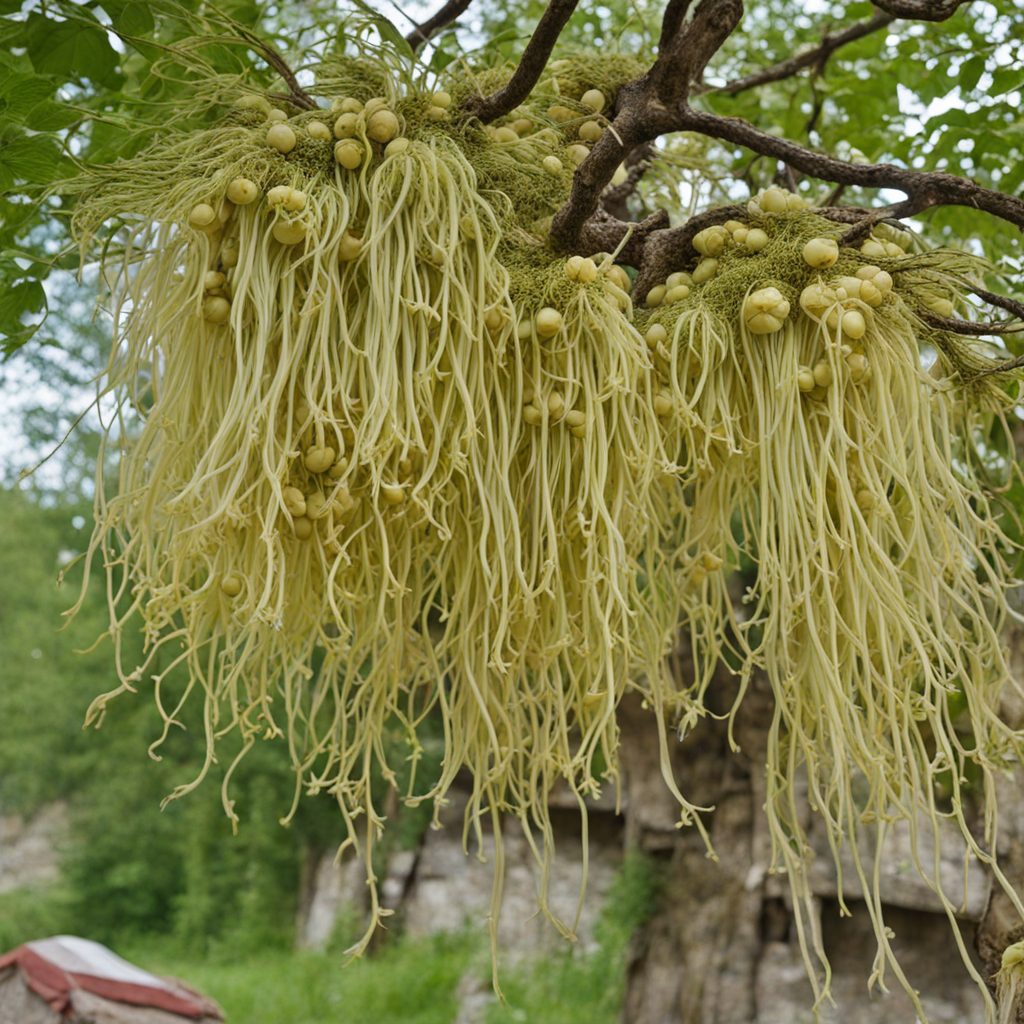Mtsvadi
Mtsvadi is a traditional Georgian dish that embodies the heart and soul of the country’s rich culinary heritage. It consists of skewered and grilled chunks of marinated meat, often pork or beef, which are seasoned with a blend of spices that highlight the flavors of the region. The marinade typically includes ingredients such as garlic, onion, and various herbs, which infuse the meat with a tantalizing depth of flavor. The grilling process, often done over charcoal, imparts a smoky aroma that enhances the overall experience, making each bite a celebration of taste and texture. The preparation of Mtsvadi is not just about cooking; it’s a social experience that brings families and friends together. Traditionally, the skewers are cooked outdoors, often during festive gatherings or family meals. As the meat sizzles over the flames, the enticing aroma wafts through the air, awakening the appetite and creating a warm, inviting atmosphere. Served alongside fresh bread, tangy sauces, and seasonal vegetables, Mtsvadi becomes a centerpiece that encourages sharing and enjoyment among those gathered around the table. Accompanying Mtsvadi, you might find sides like fresh cucumber and tomato salad, or even a spicy adjika sauce that adds a kick of heat. The combination of the succulent, juicy meat with the bright, refreshing sides creates a well-rounded meal that is both satisfying and invigorating. For those looking to delve into Georgian cuisine, Mtsvadi offers a delicious gateway to explore the dynamic flavors and rich traditions that define this vibrant culture.
How It Became This Dish
The History of 'მწვადი': A Culinary Gem of Georgia Georgia, nestled at the crossroads of Europe and Asia, is a country renowned for its rich culinary heritage, diverse landscapes, and vibrant traditions. Among its many gastronomic treasures, 'მწვადი' (mtsvadi) holds a special place in the hearts and palates of Georgians. This grilled meat dish, often served with fresh vegetables and aromatic herbs, is more than just food; it is a symbol of hospitality, culture, and the enduring spirit of the Georgian people. #### Origins of Mtsvadi The origins of mtsvadi can be traced back to the ancient culinary practices of the Caucasus region. Historical records suggest that the art of grilling meat over an open flame is as old as human civilization itself. The earliest references to meat skewering can be found in texts dating back to the 5th century BC, when nomadic tribes roamed the fertile valleys of Georgia. These tribes, relying heavily on livestock for sustenance, discovered that grilling meat not only enhanced its flavor but also preserved it for longer periods. The word 'mtsvadi' itself is derived from the Georgian word 'tsvadi,' which means 'to grill.' Traditionally, mtsvadi consists of marinated pieces of pork, lamb, or beef that are skewered and cooked over a charcoal fire. The choice of meat often reflects regional preferences, with lamb being particularly popular in rural areas, while urban centers may favor pork or beef. #### Cultural Significance Mtsvadi is much more than a mere dish; it embodies the essence of Georgian hospitality and communal spirit. In Georgia, sharing a meal is an essential part of social life, and mtsvadi is often at the center of gatherings—be it a family celebration, a wedding, or a festive feast. The act of grilling meat outdoors brings families and friends together, fostering bonds and creating lasting memories. The ritual of preparing mtsvadi is steeped in tradition. It is customary to marinate the meat in a mixture of spices, herbs, and sometimes even local wine, allowing it to absorb flavors that reflect the region’s agricultural bounty. Common ingredients include garlic, onions, coriander, and black pepper, while the use of local wines—especially the famous Georgian reds—adds an authentic touch. This practice not only enhances the taste but also showcases the importance of local produce in Georgian cuisine. Mtsvadi is often served with traditional side dishes, such as 'puri' (bread), 'tkemali' (sour plum sauce), and fresh salads made from seasonal vegetables. The combination of flavors and textures creates a harmonious meal that is both satisfying and invigorating. Eating mtsvadi is typically a communal experience, where diners gather around a table, share stories, and toast with glasses of 'chacha' (a potent Georgian grape brandy) or local wine, further emphasizing the significance of togetherness in Georgian culture. #### Development Over Time The evolution of mtsvadi reflects the broader changes in Georgian society and culinary practices over the centuries. During the Middle Ages, Georgian cuisine began to flourish, influenced by various cultures due to the country's strategic location along trade routes. The introduction of spices and cooking techniques from Persia, Turkey, and even the Mediterranean began to shape the flavors and presentation of traditional dishes, including mtsvadi. Throughout the tumultuous history of Georgia, particularly during periods of foreign invasion and occupation, the resilience of the Georgian people was mirrored in their culinary traditions. Despite external influences, the fundamental essence of mtsvadi remained intact. The dish became a symbol of national identity, particularly during the 20th century, when Georgia experienced political upheaval and a struggle for independence. In the post-Soviet era, as Georgia embraced its cultural heritage and sought to reclaim its identity, mtsvadi experienced a renaissance. The emphasis shifted from mass-produced Soviet-style cuisine to a revival of traditional culinary practices. Mtsvadi, once a simple street food, began to be celebrated in restaurants and homes alike, showcasing the diverse regional variations that exist throughout the country. Today, mtsvadi is not only a staple of Georgian cuisine but also a representation of the country's vibrant culture on the global stage. Georgian restaurants around the world proudly feature mtsvadi on their menus, introducing international diners to its rich flavors and communal eating style. Festivals celebrating Georgian food and wine often highlight mtsvadi as a centerpiece, further solidifying its status as a cultural icon. #### Modern Interpretations and Global Influence In recent years, the globalization of cuisine has led to new interpretations of mtsvadi. Chefs in Georgia and beyond are experimenting with different marinades, cooking techniques, and presentations, while still honoring the traditional roots of the dish. Some modern variations include vegetarian options—using grilled vegetables or alternative proteins—catering to evolving dietary preferences and expanding the dish's appeal. Moreover, the rise of food tourism has played a significant role in promoting mtsvadi as a must-try dish for travelers visiting Georgia. Culinary tours often include opportunities to learn the art of grilling mtsvadi, complete with hands-on experiences in local homes or traditional restaurants. This not only preserves the traditional methods of preparation but also fosters a deeper understanding of Georgian culture and hospitality. #### Conclusion Mtsvadi is a culinary treasure that encapsulates the rich history, cultural significance, and evolving nature of Georgian cuisine. From its ancient origins as a method of preserving and enhancing the flavor of meat to its modern-day status as a symbol of hospitality and national pride, mtsvadi continues to bring people together around the table. As Georgia strides confidently into the future, embracing both its traditions and contemporary influences, mtsvadi remains a steadfast reminder of the importance of community, celebration, and the shared joy of food. In every bite, one can taste the history, resilience, and warmth of the Georgian spirit—a spirit that, like the flames of the grill, continues to burn brightly.
You may like
Discover local flavors from Georgia







